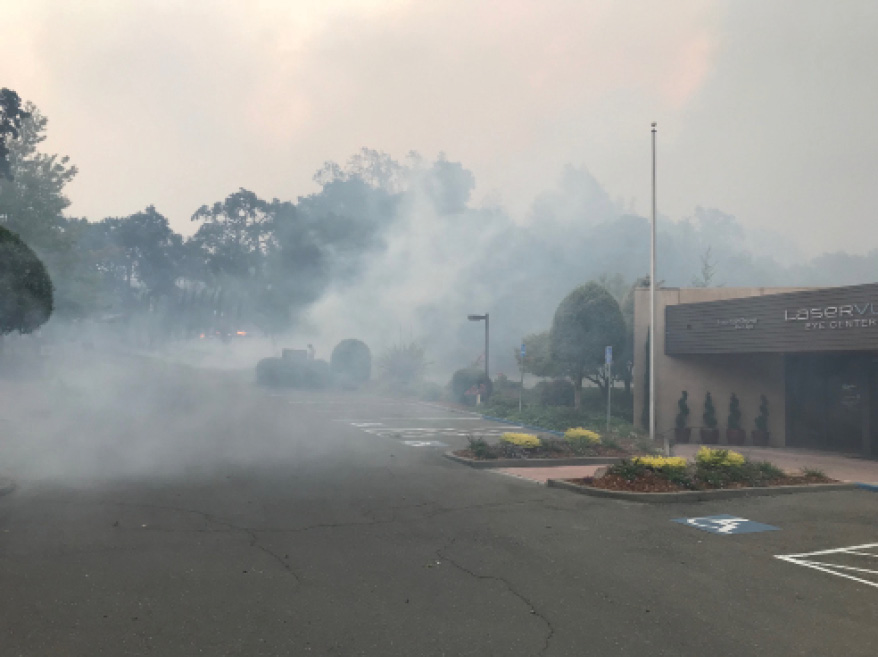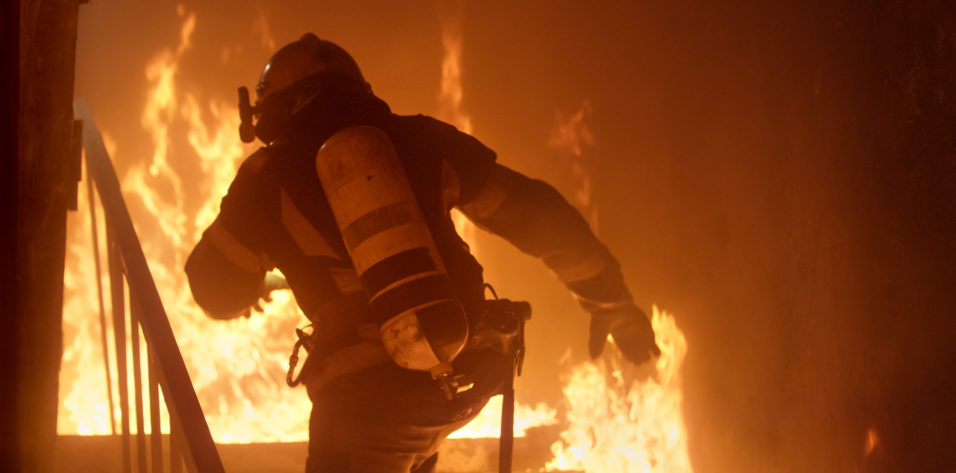
On Sunday night, October 8, 2017, my two boys (ages 12 and 8 at the time), my wife, and I went to sleep around our normal 10 pm bedtime, anticipating a full week of school and work ahead. It was a beautiful but slightly eerie night in our picturesque area of Sonoma County, California, on the northern edge of Santa Rosa. The wind was howling, and, as the night progressed, the howl morphed into a raging scream. The windows were whistling from the wind, and the house was actually shaking. We were asleep, but only lightly so, as the sound and the fury of the wind were inescapable.
At 1:16 am on Monday, October 9, in our somewhat isolated cul-de-sac in hilly terrain, someone very loudly banged on our front door. I came down but didn’t open the door, as it was hardly a normal event to have visitors at that time of night. The person on our doorstep saw me against the inside of the door and yelled that the neighborhood was on fire. As he left the front porch and returned to his car, I opened the door and saw a giant wall of flames down the hill, about 300 to 500 yards away.
My wife and I quickly jumped in two of our cars with our boys and our dog, with nothing else but the clothes on our backs. We both raced down the hill a few miles. We started to check into a nearby hotel, but just as we were about to be given our room key the electricity went out, and someone yelled that the fire was approaching the hotel.
We rushed back to our cars and drove several miles further south and finally, after trying a few that had already filled up, checked into another hotel. Again, this hotel had no power.
Preparing for an Emergency
- Try to keep an inventory of all your possessions at home or in the office, with receipts, and scan the information for storage in the cloud.
- Insurance companies want pictures of your possessions. The best thing to do is take a video of valuables such as artwork, treasured possessions, equipment, and contents of your closets, and, again, store the video in the cloud.
- Your personal pictures are also irreplaceable valuables. Get them scanned, digitized, and uploaded to the cloud.
- Check with your insurance company: If something happens to your home or office, does your policy cover the cost of the loss or the replacement cost of rebuilding? Is there adequate provision for alternate (interim) living expenses or business interruption insurance in case of catastrophic loss?
A LONG, STRANGE NIGHT
Thus began a long and strange night, followed by several long and strange months, the significance of which I am only now beginning to unpack. From what I saw and felt when we left our house, I was pretty well convinced that it must have completely burned down. My LaserVue office, practice, and brand new ambulatory surgery center (ASC) were just a few miles away from the house, straight in the line of the fire.
The news reports were not optimistic. TV crews were stationed in front of the Kaiser Permanente Santa Rosa Medical Center—the hospital across the street from my office—and the reporters were saying that, although the Kaiser facility was at that time intact, fires were raging just behind it. From the TV images, it looked like the flames were right around my office. The reporters were also pointing to a senior living compound that was burning just across the street from my office. Reporters said that propane tanks at that compound were blowing up, and large explosions were occurring in the area.
My hopes were dim. I was sick to my stomach thinking of the 3 years that had gone into building the ASC—how we had been on the cusp of an exciting new period, and how devastating this would be for our employees. As the broader regional scale of the catastrophe began to become clear, it was mind-boggling to think of an entire city burning down and the potentially large loss of life. How much time would be required just to grieve and recover, much less rebuild?
THE AFTERMATH
It took more than 3 weeks for the fires to be sufficiently contained for us to be able to reenter the area around either my office or my home. Within days of that first night of the fire, however, we heard that every house in our neighborhood (many hundreds) were in ashes, with the exception of just a few. About 3 days after the night when we fled our home, a friend of mine who is a city worker—and therefore one of the few allowed into the area on official business—took a photo of the remains of our house, unfortunately confirming that our house was not one of the lucky ones (Figure 1).

Figure 1. Three days after the fire, this was the location of Dr. Bansal’s family home.
A few weeks later, when the New York Times reported on the progress of the racing inferno, we learned that our house had likely burned down completely around 1:30 to 1:45 am on that first night—just minutes after we received that knock on our door from a mysterious stranger, the knock that potentially saved our lives. We also learned later that it was fortunate we had turned left rather than right after driving out of our cul-de-sac. Had we turned right, we might have run into the rapidly racing wall of flames that was approaching from many sides.
THE GOOD SAMARITAN
It is humbling and mind-boggling to think of all that we received that night—the gift of life. A stranger had miraculously wandered, amid the heat of raging fires, into an isolated cul-de-sac that was easy to miss because it had a different elevation from the main street. We have since found out that none of our neighbors in the cul-de-sac were home that weekend, and we have not been able to identify our Good Samaritan. He does not appear to have been a neighbor or an emergency worker.
Our neighborhood was one of the first populated areas to burn down after the initial sparks of the fire started just a few hours earlier, about 15 miles away in dry tinderbox conditions. It spread at a devastating speed with 70-mph winds in the middle of the night. Because of this speed, the first responders had not yet appeared, and the city had not yet issued an evacuation warning for our area.
When we finally were able to enter our neighborhood many weeks later, we witnessed firsthand the burnt-out and toxin-filled devastation. The area, previously a paradise, looked like it had been the epicenter of a nuclear detonation.
My family and I ended up staying more than 2 months in a hotel, as there was little available housing stock and huge price run-ups that continue to this day. We have now moved into a new interim home, but we look forward to rebuilding along with many of our former neighbors. My wife, who is also an ophthalmologist, very ably handled all the dealings, oftentimes frustrating, with insurance companies related to our home and possessions, while I focused on the recovery of our practice.
STILL BURNING
As for the office and practice, 2 days after the initial blaze started, we received informal word that the LaserVue office building and ASC seemed to be miraculously intact, even though buildings across the street had been completely burned down and the senior living facility was in ashes. But we also heard that fires were still blazing around the office area. We received a photo of flames in the yard of the office building, suggesting that things were still very volatile (Figure 2).

Figure 2. Flames were visible in the yard of Dr. Bansal’s LaserVue office building.
At that point, no one could get into the area to help put out the flames, and stretched firefighting resources were being deployed only to assist in evacuations, to save human life, and to contain the spread of fires at the perimeter. Because there was no capacity for firefighters to put out recurring flames to save property in already burned areas, the prospect that the flames in the yard of our office would go unattended was very real.
Two days after that, as our uncertainty lingered, we saw on TV a reporter standing at a corner just yards from our office building, describing the devastation of the commercial buildings in the area. My sister, who was watching the newscast live on the web in the Midwest, realized that the reporter was talking about buildings being down on every corner except the one that included LaserVue. She reached out to the reporter on Facebook, and the reporter replied immediately. At my sister’s request, the reporter walked over and was able to confirm that the building was intact, although all the lawn and trees outside it were burned. She even sent a photo of it. The miracles continued….
THE TUBBS FIRE
In all, the Tubbs fire, as it came to be known, was the most destructive wildfire in California history, burning portions of Napa, Sonoma, and Lake Counties. By the time it was contained 3 weeks later, on October 31, the fire was estimated to have burned 36,807 acres (57.5 mi2). At least 22 people in Sonoma County had been killed by the fire, which, though the largest, was just one of a dozen large fires that struck Northern California at the same time, under the same dry conditions.
The Tubbs fire incinerated more than 5,600 structures, including more than 2,800 homes in Santa Rosa, where the damage was estimated at $1.2 billion, with 5% of the city’s housing stock destroyed. One of every six physicians in Santa Rosa lost their homes, and several of those physicians performed heroics to save their patients even as they left behind their families while their homes burned. Many less well-off and uninsured or underinsured individuals experienced and continue to experience immense hardship.
THE AFTERMATH
As I look back on the night and months when our community burned, grieved, and changed, I can’t help but feel immense gratitude that those close to me are alive, that the kindness of a stranger helped save my family, and that my colleagues and I are able to remain a productive force for our community. Although LaserVue was closed for several weeks, as the entire area was inaccessible and we were unsure if we even had an office and ASC remaining, we immediately checked up on our employees and reassured them that they would remain on salary.
This story has been about the impact of the fire on my family and practice, but I should mention that six other ophthalmologists lost their homes the same day I lost mine. Several ophthalmologists who practice in my area but whose offices were not affected by the fire offered to let me use their offices while my center was inaccessible. It is experiences like this that help one figure out what is important and what is not.
The community as a whole rallied together, determined to rebuild stronger than ever. A slogan was coined: “#SonomaProud. The love in the air is thicker than the smoke.”
Fire is a powerful and destructive force, as well as a potentially purifying and healing force in just about all spiritual traditions. It is up to each person whether to treat fire’s destruction as a tragic loss or as an opportunity for transformation and healing. In the fire’s aftermath, I saw up close examples of both: people mourning and nearly broken apart by the loss of all their material possessions, and people humbled and broken open by the opportunity to purify and lighten.
Hippocrates recognized fire’s force in medicine: “What medicines do not heal, the lance will; what the lance does not heal, fire will.” In laser eye surgery, a cool light beam is used to burn and reshape the cornea so that it more accurately focuses light and improves vision.
So, too, with the Tubbs Fire. For me, it has become a source of positive energy and transformation. I am grateful to be alive and healthy. I am grateful for the generous selfless spirit of a stranger. And I am grateful for the opportunity for a new life—to clear the rubble, to let go of and purify all the things and all the ways of being and seeing that in the end do not serve me or others.
I am grateful not just to have sight of all the opportunities that lie ahead for service to others—patients, family, employees, colleagues, and community—but also to have been offered the gift of burning insight that often comes only in the wake of large-scale devastation.
They say that after the storm comes the calm and the sunshine. This firestorm, for me, has brought on a sort of reshaping of my internal cornea, and I hope this will lead ultimately to improved insight, allowing me to be stronger and wiser in service to my patients, my family, my community, and my profession. With deep gratitude to so many, and for so much.


